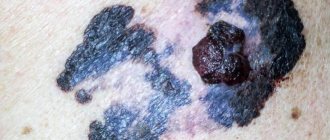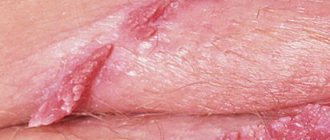Causes of acne on the genitals
Dermatologists and gynecologists have established several reasons why pimples occur on the labia majora. The main ones:
- Inflammation of the follicle. The labia are covered with hairs that play a protective role. Sometimes the hair follicle can become inflamed, causing redness and a pimple. In most cases, such a tumor does not require treatment and goes away on its own. However, it is necessary to control the development of inflammation until the pimple disappears completely.
- Expansion of sebaceous pores. Often seen in teenagers or during menopause. The endocrine system is actively changing and can provoke expansion of the sebaceous glands. The pores become clogged due to excessive sebum and acne occurs.
- Low immunity. When immunity decreases, for example, due to a long-term illness, diabetes, pregnancy, the body ceases to function normally, and all pathologies worsen. The body's protective functions become insufficient to resist various viruses and bacteria.
- Insufficient hygiene. You need to take a shower every day, use special soap without fragrances and scents, change panty liners every four hours, and menstrual pads - when soiled, but at least every 4 hours. Failure to follow these rules can result in painful acne on the labia.
- Synthetic underwear. This factor plays a big role in feminine hygiene. Many of the fair sex prefer thongs and lace synthetic panties - this is extremely wrong. Synthetic underwear does not allow air to pass through well and absorbs excess moisture, thus creating a kind of “greenhouse effect”. The skin breathes poorly, and bacteria begin to multiply, causing acne and irritation.
- Allergic reaction. The microflora of the genital organs is very sensitive, therefore it reacts to external factors. New soap, shower gel, body cream, pads are not always suitable for the owner, and allergies will manifest themselves in the form of blisters and pimples on the big lip.
- What types of pimples can be found on the labia of women?
We are accustomed to simply calling all formations acne, but they may differ. Depending on the appearance, acne indicates different causes and diseases. Before you run to the doctor, you should conduct an examination yourself and understand what, besides the pimple itself, is bothering you. Having compiled a complete picture of the problem, it will then be easier and simpler for the doctor to make a diagnosis. So, the main formations that you can see on the labia are as follows.
Symptoms
At the doctor’s appointment, the patient undergoes a routine gynecological examination, focusing the specialist’s attention on the neoplasm. He will examine and palpate the tumor in detail, ask you about what other symptoms are bothering you in order to find out why there is a lump at the entrance to the vagina.
Let's take a closer look at diseases characterized by the appearance of formations on the skin.
Bartholinitis
Most often, it is bartholinitis, an inflammation that affects the Bartholin glands located at the base of the labia. And the disease manifests itself as a lump at the entrance to the vagina, due to the fact that pus has accumulated in the blocked duct.
The appearance of exudate is associated with the proliferation of bacteria such as mycoplasmas, trichomonas, chlamydia, and gonococci. In simpler cases, we are talking about E. coli, staphylococci, streptococci, or Candida fungi, known to many. In this case, the ball near the vagina is nothing more than an abscess.
The main symptoms of bartholinitis:
- hyperemia of the skin around the affected area;
- swelling of the gland;
- pain when touched or moved;
- increased body temperature;
- the entrance to the vagina is temporarily blocked.
An abscess can be either false or true. If the lump near the vagina is caused by a true abscess, then the tissue where the gland is located seems to melt, intensifying the symptoms listed above. With such purulent inflammation, nearby lymph nodes also become enlarged, and the outer labia may swell. General health is disturbed - the woman feels weak, especially if the temperature is elevated.
An opened abscess may not empty completely, then there is a risk of relapse.
When bartholinitis becomes chronic, an exacerbation occurs during menstruation. In addition, a lump at the entrance to the vagina will appear again when the immune system is weakened or in the presence of other chronic diseases.
When the acute period has passed, a cyst may appear at the site of formation - a compaction that reminds of itself with mild discomfort when changing body position or when moving.
So, we found out that bartholinitis is a painful lump near the vagina, the cause of which is microbes that cause inflammation of the glands.
Cyst
Quite rarely, the neoplasm is a cyst, but it will not be superfluous to learn the features of this pathology. A cyst is a cavity filled with either fluid or epithelial tissue.
The ball at the entrance to the vagina has walls and contents. It can appear due to injury or from birth. The woman learns about her problem during the examination, since the cyst does not bother her in any way due to its small size. If the compaction is large, then the following symptoms may occur:
- feeling that something is bothering you;
- discomfort during sex;
- problems with urination and bowel movements.
Upon examination, the cyst is the same as the rest of the skin - smooth and painless. When bacteria attach, pain and discharge will appear. It may open on its own in this case.
Tumors
A lump at the entrance to the vagina can be a lipoma, fibroma, or fibromyoma. These neoplasms are benign. They appear from the vaginal walls. They show no signs of increased growth. There are usually no symptoms if the tumor is small. They are found when examined on the front of the vagina.
Carcinoma
The most dangerous lump near the vagina is carcinoma. It is a cancerous tumor. Most often, carcinoma is secondary and spreads from the uterus and cervix through metastases. Some patients do not complain. Typically, carcinoma is characterized by the following symptoms:
- spotting between periods;
- liquid discharge - cloudy or white;
- constant pain syndrome in the later stages.
As the tumor grows, problems with defecation and urination may occur. Of course, the woman’s general condition also suffers due to intoxication. If you have a tumor near your vagina, the first thing to do is rule out carcinoma. Especially if you have reached menopause.
Ulcers: white and yellow
This pimple on the labia majora hurts and brings minimal discomfort. There is pus inside, which, after maturation, comes out on its own. It is impossible to crush such ulcers, because you can spread the infection to healthy skin. Most often, ulcers with cloudy contents are the result of improper personal hygiene, hypothermia or overheating. With good immunity, they go away on their own and do not require a trip to the doctor. It is enough to simply treat the abscess with an antiseptic. Sometimes, the bacteria spread to the subcutaneous tissue and a boil develops. A large pimple forms on the labia. It hurts and affects a woman’s well-being. In this case, a trip to the doctor is extremely necessary, because only he can correctly open the ripening purulent boil.
From lyrics to medicine
How aesthetically pleasing and attractive this phenomenon is is an entirely subjective opinion. But there is an important aspect from the field of medicine that you should definitely know about.
The symptoms of moles on the genitals are very minor, do not bother and cause discomfort. They are usually discovered when visiting a doctor. Signs indicating degeneration of pigment formations are as follows:
- There is an increase in size.
- Manifestations of discomfort, pain, burning and itching in the area of growths.
- Redness or darkening, the appearance of roughness, bumps, peeling, and a blurred outline appear.
- The upper covers of the nevus bleed, become moist and macerated.
Medicines and treatment methods are chosen exclusively by the attending physician, after a diagnosis as part of a consultation of a gynecologist, oncologist, and allergist. The choice of treatment procedures is quite large - classic topical medications based on potent ingredients, herbs or natural bases. Cryotherapy, laser beam or directed electrical flow are widely used. The main thing is to never treat yourself.
Every person has moles. Many of them appear immediately after birth and are not dangerous. However, the formation of moles in intimate places can cause concern, so the question of their removal is relevant.
Bloody pimple and blister on the labia majora
The first thing to suspect about blisters is lice and mites, which are sexually transmitted. Associated symptoms will be itching and redness in the genital area. The mite can only be seen with high magnification, but genital lice are visible to the naked eye. If they remain on the body for a long time, they form dark spots - their breeding places. If you suspect genital lice, you should urgently consult a gynecologist, because at home the treatment process may be delayed.
Not only unwanted “residents” provoke red pimples on the labia majora. The allergic reaction also manifests itself as redness and pimples. Therefore, think carefully about whether you have changed your personal hygiene products or contraceptives. After all, they may not suit you and have a detrimental effect. To eliminate allergic acne, you need to remove the allergen and treat with antihistamines. Only a doctor can choose them correctly; Cetrin and Suprastin are often prescribed. For local effects, special ointments are prescribed.
The most dangerous cause of red blood pimples may be syphilis. In addition to the genitals, it can cover any point on the body. The formations do not hurt, but they are extremely contagious, and therefore require immediate treatment from a venereologist.
Molluscum contagiosum
The appearance of molluscum contagiosum is also caused by infection with a viral agent. The formation appears in the groin area and represents a small bulge on the skin or mucous membrane with white, curd-like contents. Usually their size does not exceed 2-5 mm.
Treatment is not necessary. If necessary, surgical methods are used to remove molluscum contagiosum, including mechanical extrusion and cleansing of the cavity, laser exposure, and cryodestruction.
Conclusion: Among the causes of acne on the clitoris, there are both physiological and pathological. That is why, if any formations occur in the intimate area, it is recommended to visit an obstetrician-gynecologist to determine the exact etiology and prescribe timely and adequate treatment.
Tags: white, clitoris, point
- Related Posts
- Fungus on the hands - causes, symptoms, folk and medicinal treatments
- How to treat toenail fungus
- Suppositories for thrush - which ones are more effective to take?
« Previous entry
Intensified pimples
Dense pimples that do not hurt, but often appear in groups, have a pointed shape, are caused by HPV. If the neoplasms are isolated and do not cause discomfort, they can be left alone. They can resolve on their own, the main thing is to increase immunity. But it is necessary to take a test for the HPV type. Some types lead to cervical cancer. If acne begins to actively grow, this indicates a decrease in the body’s protective functions and can be an alarm bell.
Genital warts are removed using laser, nitrogen or electrocoagulation. But no one can guarantee that acne will not recur. It is imperative to undergo antiviral therapy.
Causes
The human papillomavirus enters a woman’s body during unprotected sexual intercourse. However, the disease does not appear immediately. Condylomas on the vulva appear at a time when the body's immune system weakens for the following reasons:
- The body has been affected by the immunodeficiency virus.
- Decrease in the level of any vitamin in the body.
- Eating disorder.
- An oncological disease.
- Chronic state of stress.
- Pregnancy.
- Disruption of the endocrine system, leading to an imbalance of hormones in the body.
- Physical damage to the mucous and epithelial lining of the vulva.
- Incorrect and incomplete hygiene of the genital organs.
- Various infectious diseases.
Are there red pimples on the labia?
The answer is yes, there are. They can be triggered by acne or acne. Severely advanced acne can be localized not only on the back, shoulders, face, but also develop on the genitals. Such formations hurt and interfere. They can be observed during menopause and with hormonal imbalances.
In addition, you can find red pimples covered with a white coating. This is an accurate symptom of the proliferation of fungi of the genus Candida. They appear more often in people with low immunity: patients with diabetes, HIV-infected people. In addition to acne, the patient experiences itching and pain when urinating. For treatment, suppositories and medications with clotrimazole and nystatin are prescribed.
Causes
A small lump on the clitoris may turn out to be a common pimple. Such skin defects can also appear in the intimate area. There are several main reasons for the formation of pimples on the external genitalia, namely:
- Skin irritation after depilation;
- Failure to comply with intimate hygiene rules;
- Excessive hypothermia of the external genitalia;
- Wearing low-quality synthetic underwear;
- Poor nutrition, abuse of alcohol, fatty and fried foods;
- Stressful situations, emotional stress;
- Long-term treatment with potent medications;
- Hormonal disorder.
Methods for treating papillomas on the clitoris
Before carrying out therapy, it is logical to perform a thorough diagnosis. Here, a PAP test will be relevant, which allows you to determine the type of virus that caused the formation. A biopsy of the growth will also be required to rule out its malignancy. The treatment regimen itself usually includes taking immunostimulants and antiviral drugs, as well as the use of external medical and folk remedies for clitoral papilloma.
Folk remedies for treating papillomas on the clitoris
Castor oil is very effective against such growths, in which you should soak a cotton pad and wipe the formation. Such procedures should be performed at least 2-3 times a day. The optimal duration of treatment is 2-3 weeks.
This oil can be replaced with sea buckthorn, coconut, lavender, and olive oil. The main thing here is that they should be cheese-pressed, otherwise their effectiveness will decrease. Before use, all this can be heated, but so as not to burn the mucous membrane.
Here are other, no less effective folk remedies for clitoral papilloma:
- Aloe juice . Cut a leaf from this plant, grind it into a pulp and squeeze the mass through cheesecloth. Wipe the papilloma with the resulting juice 3-5 times a day using a cotton pad. This procedure should be carried out within 1-2 weeks. It is necessary to prepare the product just before use so that its benefits do not disappear.
- Green tea . Brew its leaves (1 tablespoon) in boiled water (200 ml), cover them with a lid and keep under it for about 15 minutes. Then strain the mixture, soak a cotton pad in the resulting infusion and wipe the formations well. Repeat these steps 2-3 times a day until the clitoral papilloma goes away.
- Potato juice . To prepare it, peel the tubers of this plant, then grind them in a meat grinder or grater. Next, place this mass on cheesecloth and press well with your fingers. The liquid that has drained during this time should be used to treat papilloma twice a day. Treatment is usually carried out over 2-3 weeks.
- Chamomile . Pour this dried herb (3 tablespoons) with boiled water (300 ml), cover with a lid and let it stand for about 3-4 hours. Then strain the mixture and use the resulting liquid to wipe the clitoral papilloma 3-5 times a day. To do this, soak a cotton pad in it, with which the growths are treated.
Important! To eliminate papilloma on the clitoris, you should not use lemon juice, baking soda, salt, garlic, onions and other products with an aggressive effect. They can injure the mucous membrane and cause a burning sensation.
Treatment of papillomas on the clitoris with medications
In the photo are preparations for papillomas on the clitoris
It is not recommended to use Ferezol, Verrukacid and other cauterizing agents with an aggressive effect to eliminate papilloma on the clitoris. They can cause burns, burning and itching of the mucous membranes, so it is better to choose the safer Super Clean product instead. It is sold in the form of a solution, in 3.6 ml bottles, the cost is about 100 rubles. (30 UAH). The composition should be applied to the clitoral papilloma using an applicator, 1-2 times in total.
Here are the drugs prescribed in addition to external agents:
- Immunostimulants . Lymphomyosot, which is a natural food supplement available in liquid form, has performed well. It is taken 30-40 drops per day, washed down with water, for a month. The cost of the drug is 450 rubles. (200 UAH). It has excellent analogues - Immunal and Imudon, which are sold in tablet form. On average, treatment for clitoral papilloma lasts 2-3 weeks.
- Vitamins . The most effective drugs are those from Doppelhertz Active, Solgar, Complivit, Perfectil, Alphabet. If we talk about supplements intended specifically for women, then it is worth highlighting the Opti Women Optimum Nutrition tablets, the cost of which is 1000 rubles. (450 UAH). On average, they are drunk for 2-4 weeks, 1-3 capsules per day.
- Antiviral . First of all, doctors recommend paying attention to the drug “Likopid”, which perfectly fights various types of HPV. It should be taken for 5-7 days, 1 tablet per day, the cost of the medicine is 600 rubles. (250 UAH). It has good analogues - Cytovir-3 and Kagocel.
For successful treatment of clitoral papilloma, it is necessary to combine the use of anti-inflammatory drugs, immunostimulants and vitamins. In addition to this, you need to use antiviral ointments, for example, Oxolinic or Salicylic. They must be applied in a thin layer 2-3 times a day throughout the week and left until absorbed.










